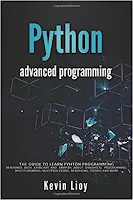Python Programming Language For Beginners
Oliver R. Simpson ... 160 pages - Publisher: UnKnown; (November, 2019) ... Language: English - ASIN: B081JBHPLV by Amazon.
If your dream is to become a Python pro, or you always want to code like a boss, solve real-world problems, build web apps, or even automate repetitive tasks, then you’ve come to the right place. By the end of this book, you will have mastered the fundamentals of Python language. You will learn how to create programs that will save you time and simplify your life. Python is a straightforward language, so even if this is your first time to learn any programming language, you can learn Python without experiencing any issues. Python has multiple applications, and so you've got a high probability of getting a great job once you become a pro in Python language.
Whether it’s in web development, data analysis, scripting, and machine learning, all require that you be experienced in Python. This is a beginner guide that will take you from absolute scratch to creating your first Python program. Not only that, but you’ll also learn lots of stuff about the Django Python framework. With Django, you will learn how to create web apps very quickly and efficiently.
If your dream is to become a Python pro, or you always want to code like a boss, solve real-world problems, build web apps, or even automate repetitive tasks, then you’ve come to the right place. By the end of this book, you will have mastered the fundamentals of Python language. You will learn how to create programs that will save you time and simplify your life. Python is a straightforward language, so even if this is your first time to learn any programming language, you can learn Python without experiencing any issues. Python has multiple applications, and so you've got a high probability of getting a great job once you become a pro in Python language.
Whether it’s in web development, data analysis, scripting, and machine learning, all require that you be experienced in Python. This is a beginner guide that will take you from absolute scratch to creating your first Python program. Not only that, but you’ll also learn lots of stuff about the Django Python framework. With Django, you will learn how to create web apps very quickly and efficiently.



















